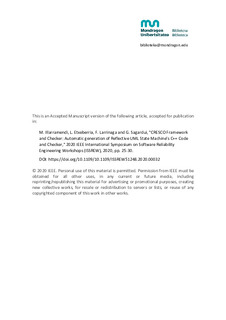
Ikusi/
Izenburua
CRESCO Framework and Checker: Automatic Generation of Reflective UML State Machine's C++ Code and CheckerBertsioa
Postprinta
Eskubideak
© 2020 IEEESarbidea
Sarbide irekiaArgitaratzailearen bertsioa
https://doi.org/10.1109/ISSREW51248.2020.00032Non argitaratua
2020 IEEE International Symposium on Software Reliability Engineering Workshops (ISSREW) Coimbra. 12-15 octubre 2020. Pp. 25-30. IEEE, 2020Argitaratzailea
IEEEGako-hitzak
Softwarea
Runtime
Safety
Unified modeling language ... [+]
Runtime
Safety
Unified modeling language ... [+]
Softwarea
Runtime
Safety
Unified modeling language
Monitoring
Adaptation models
Hardware [-]
Runtime
Safety
Unified modeling language
Monitoring
Adaptation models
Hardware [-]
Laburpena
Software Systems are becoming increasingly complex leading to new Validation & Verification challenges. Model checking and testing techniques are used at development time while runtime verification ai ... [+]
Software Systems are becoming increasingly complex leading to new Validation & Verification challenges. Model checking and testing techniques are used at development time while runtime verification aims to verify that a system satisfies a given property at runtime. This second technique complements the first one. This paper presents a tool that enables the developers to generate automatically reflective UML State Machine controllers and the Runtime Safety Properties Checker (RSPC) which checks a component-based software system's safety properties defined at design phase. We address embedded systems whose software components are designed by Unified Modelling Language-State Machines (UML-SM) and their internal information can be observed in terms of model elements at runtime. RESCO (REflective State Machines-based observable software COmponents) framework, generates software components that provide this runtime observability. The checker uses software components' internal status information to check system level safety properties. The checker detects when a system safety property is violated and starts a safe adaptation process to prevent the hazardous scenario. Thus, as demonstrated in the evaluated experiment but not shown in the paper due to the space limitation, the safety of the system is enhanced. [-]





















